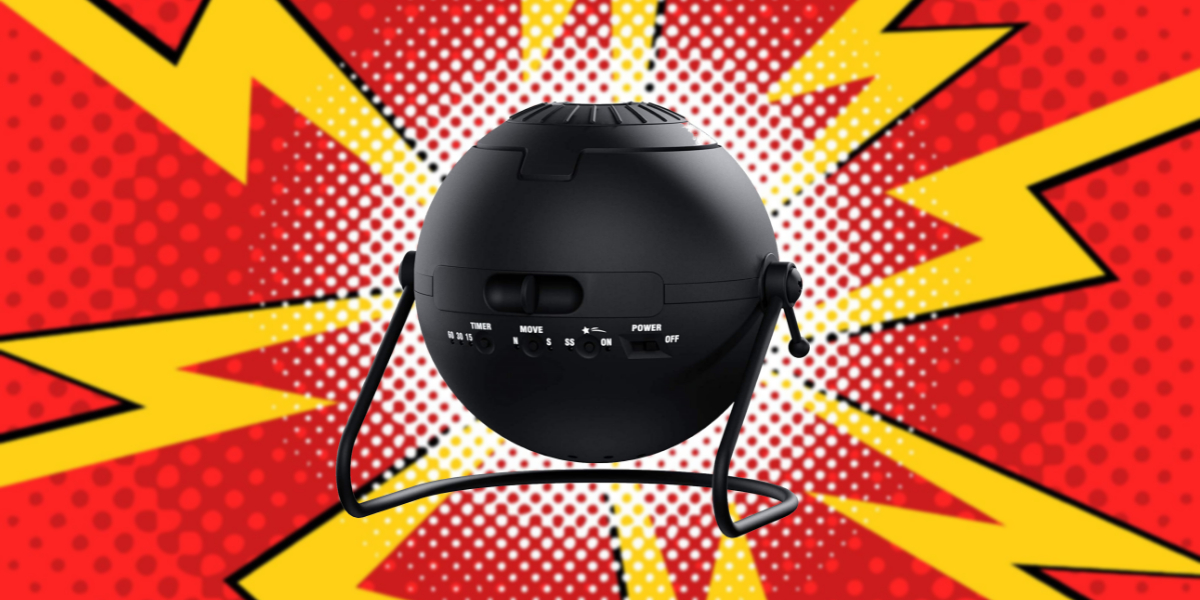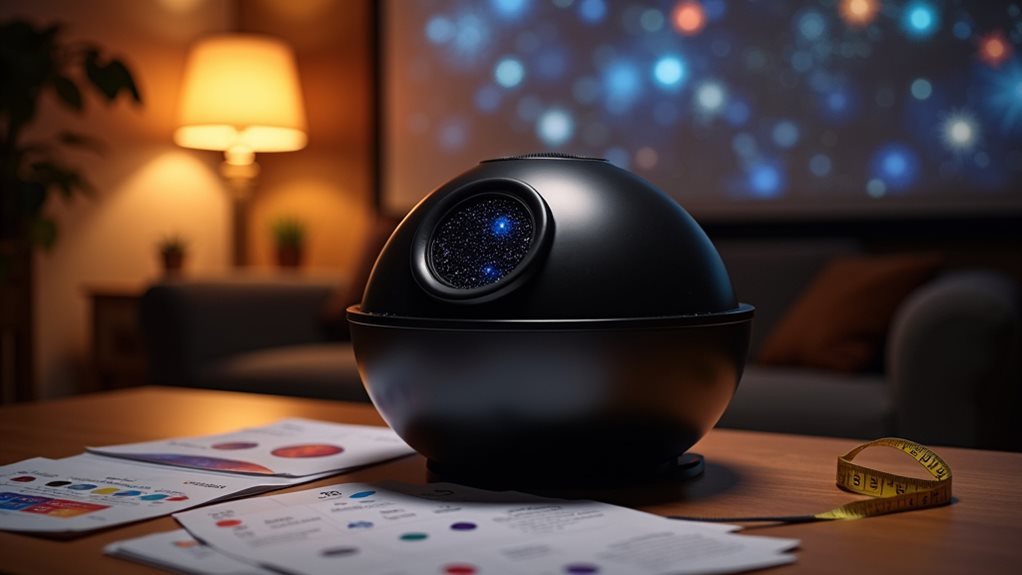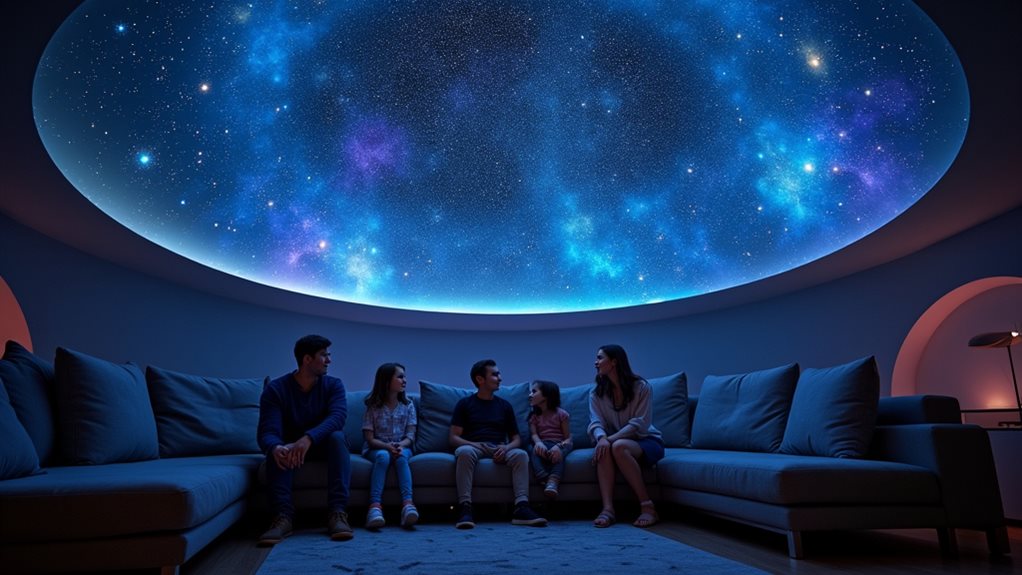Home planetariums are incredibly popular, allowing people to bring the outside night sky indoors and enjoy a view of the stars no matter what the weather.
The best home planetarium is the Sega Toys Homestar Flux. It offers a good price to performance, has a wide range of projection discs available, and is a nice compact unit that can be stored away when not in use.
Look online, and you’ll see a wide range of products and pricing, some starting as low as $30 while some cost upwards of $500, so why pick the Flux?
Why the Flux is the top pick
I reviewed the Flux many years ago. It is the follow-up to the very popular Sega Toys Original Home Planetarium and ever since my review I’ve tried a number of other products which have been good, but not offered the price point or versatility of the Flux.
Sega Homestar Flux Key Features:
- Projects 60,000 stars
- 5-watt warm white LEF technology
- Powered by USB
- 30+ optional discs available
- Easy to use
It improved on the Original by increasing the bulb brightness and swapping the power block to a USB version. It retained the ability to swap out the projection discs, giving you the option to expand your collection and have different scenes you can project onto your ceiling or wall.
Whenever I’ve used the Flux it only takes a moment to set up. It’s a compact little projector that can be popped on a bedside table and still leave room for other items (e.g. alarm clock).
I like the simplicity of the device, it has simple controls for rotating the disc and adding a shooting star, a fun optional effect that brings the night sky to life.
There is a focus ring to get the image nice and crisp and it can be easily positioned to face up at the ceiling or sideways at a wall.
It’s popularity has ensured it is widely available in many countries via Amazon, you can check your local store via this link: https://geni.us/AmazonFlux
What about the Dark Skys 1?
In terms of luxury there’s no denying the DS-1 is the best home planetarium money can buy. It offers a LOT more stars projected, backlit controls and a beautiful night light option.
There’s no denying the DS-1 is an amazing home planetarium…with a price tag to match! The $579 price tag puts it out of reach of most people, and since launch it’s been primarily available in the USA only, if you live outside of America you can’t get hold of one.
How does it compare to the Flux? This was a question I got asked a lot so I made a video to demo both projectors.
Both are very good, however when you take price and availability into account I think the majority of people would be very happy with the Flux.
Star Projectors are NOT the same as Planetariums
When shopping online you’ll undoubtedly come across lower cost products, often listed as ‘star projectors’. While claiming similar functions these are very different products. These lower cost devices typically use a laser to project dots of light, the ‘stars’, and usually have some additional projection acting as a nebula.
These are great for young children who just want a nice light show, they’re not for people wanting to see the night sky accuratly.
There is another common difference: ambient light. In this video I demonstrate a range of different products, including the Flux.
I demonstrate not only the different projection effects but also the ambient light given off by each unit. The lower cost star projection devices light up the room with a lot of ambient light whereas the more expensive planetariums have very little ambient light.
I tried a total of 7 different products in this video:
- Zenoplige Galaxy: https://geni.us/AmazonZenopligeGalaxy
- Nebula: https://geni.us/AmazonNebulaProjector
- Purple Galaxy: https://geni.us/AmazonPurpleGalaxy
- Ocean Wave: https://geni.us/AmazonWaveProjector
- Original: https://geni.us/AmazonSegaOriginal
- Flux: https://geni.us/AmazonFlux
- DS1: https://dark-skys.com/
Aside from the DS-1 the above links all lead to Amazon.
If you’re someone who wants to lie back and pretend you’re looking up at the night sky the last thing you want is a lot of light in the room, I much prefer the darkness provided by the Sega Toys and Dark Skys planetariums.
How to decide which home planetarium to buy
With so many options to pick from just how do you decide what to go for?
Expectation
What expectation do you have for a home planetarium? As you can see in the comparison video above there is a big difference between laser dot star projectors and accurate night sky projectors. And while most people expect the planetarium will project static images albeit one that rotates) some expect to get a similar experience to institutions which offer to whizz you around the solar system on an immersive film like tour of space. Those wanting to ‘whizz through space’ are more likely to be interested in planetarium software rather than projectors.
Size
As with any home purchase, do you have space for it? Projectors come in a range of shapes and sizes, most are designed to be compact and can easily fit on a bedside table.
The Sega Homestar Flux is a very compact unit measuring 16cm x 16cm x 15cm and weighing just 620g. The DS1 is a bigger unit that measures 27cm tall and has a base diameter of 18cm.
Also keep in mind you will need to power the unit so need to have a power outlet close to it’s location.
Brightness and Ambiant Light
To be able to project onto a ceiling it needs to be bright enough, be sure to check the wattage of the projector as the higher the wattage the brighter the image and the greater the tolerance for ambient lighting.
The Sega Toys Homestar Original uses a 3-watt projector, the updated Homestar Flux uses a 5-watt projector and the difference is noticeable. There has been much debate over which looks best and although it’s personal preference our recommendation is the brighter Flux as it offers a crisper experience without having to completely blackout the room.
As demonstrated in the video above there is a big difference in the amount of ambient light given off, with lower cost devices lighting up the room a lot brighter than the more premium products.
Realism
Are you interested in seeing the night sky as you would if looking into the sky, or do you just want a projection of stars, you’re not fussed about if the correct constellations are showing.
Higher cost projectors often come with replicas of the night sky, with a choice of viewing stars only or stars with the constellations and their names showing.
The advantage of a realistic sky is it is not only decorative and beautiful to look at, it’s also educational and allows you to learn to navigate the sky from the comfort of your home before venturing out to look up at the real thing.
The Sega Toys Homestar Flux can project up to 60,000 stars, the DS-1 turns that up to 11 with the ability to project 4.1 MILLION stars!
If you’re buying for a young child you may want to go for a lower cost option that projects a generic star field, usually around 10,000 stars.
Features
These are all potential features to check for in a home planetarium:
- Timer function: Can it be set to automatically turn off after a period of time? This feature is used when people want to drift off to sleep under a projected night sky.
- Image rotation: Does the projection stay still or can it be rotated?
- Shooting stars: Are there any additional shooting star animations to bring extra visual flare to the projection?
- Inbuilt speaker: Some have speakers built in, not essential as they’re usually poor quality.
- Optional scenes: Can you purchase additional discs with different scenes or are you restricted to the discs provided with the planetarium?
- Adjustability: Some people have low ceilings, some people have high ceilings. Some will project from the floor, others will project from a bedside table. You may not want to project on the ceiling at all, instead you might want to project on a wall or floor. Make sure you can adjust the angle and focus so the projection will work for your situation.
Optional Discs
Many low cost devices I’ve tried are a single projection, they don’t offer the ability to change things up. I’ve also tried some projectors that are limited to the one or two discs included with the projector.
The Homestar Flux has access to a range of discs that allow you to change up the projection, instead of stars you could be gazing at the Universe with Galaxies or looking at the Earth handing in Space.
Check what discs come as standard, often this will be a Northern Hemisphere disc along with disc showing the constellations.
Delivery Options
While many products will be widely available via online retailers such as Amazon there are some products which may have restricted delivery options, or may incur additional charges when ordering.
The DS-1 isn’t available for order on Amazon, you need to purchase directly from the manufacturer who is based in America.
If you do order from overseas keep in mind you will likely pay higher shipping costs and, in the UK, additional tax when the item arrives.
Power Supply
Check how the unit is powered and what type of power supply is included. Most come with an AC cable and will require a power outlet nearby, the power cables aren’t very long. Others, such as the Homestar Flux, can be powered via a USB cable, meaning it can be plugged into a power outlet or run from a battery pack.
Price
The big one: price! What’s your budget? Does the product you want fall into your budget? These products are a luxury item, don’t over stretch yourself when it comes to investing in one.





